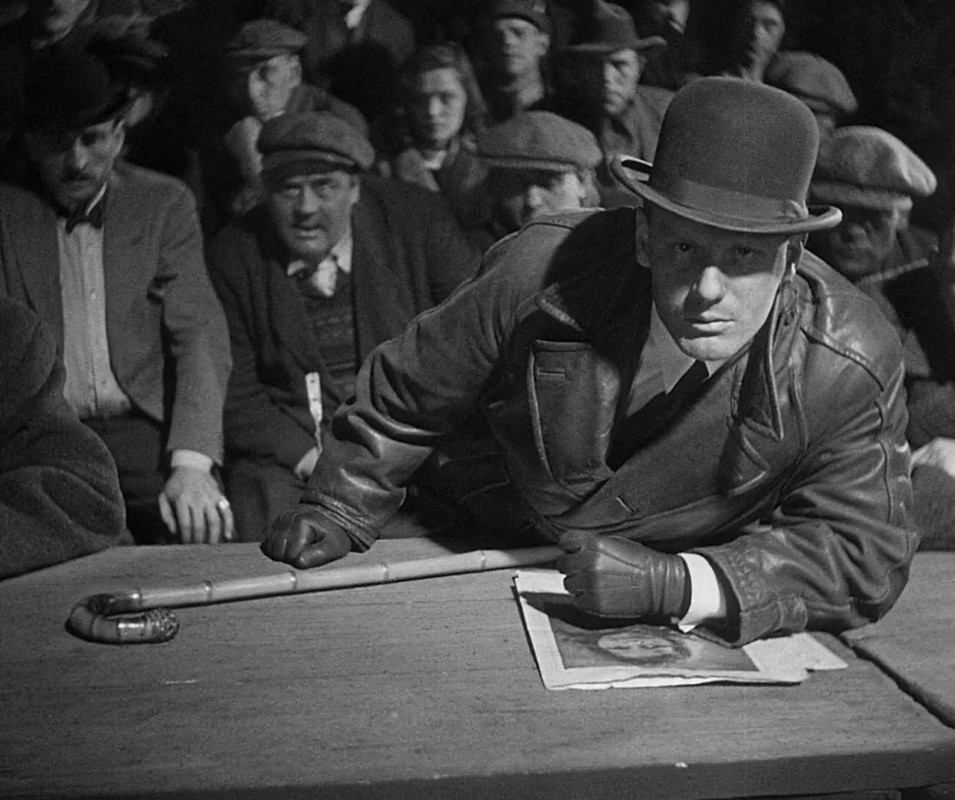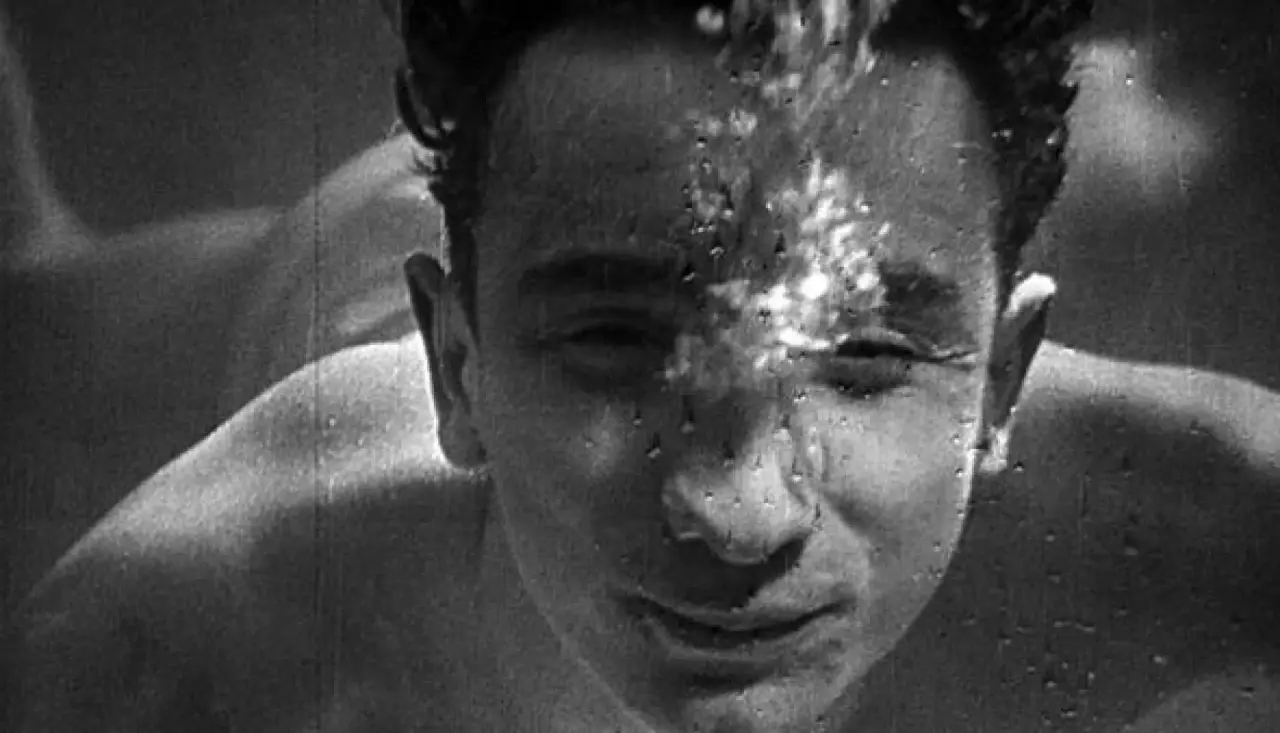“Selling the Brooklyn Bridge again, huh?”Every Day's a Holiday (A. Edward Sutherland, 1937)
Nov
21
National Entrepreneurs Day

Lobbycard. Peaches O'Day (Mae West, dressed by Schiaparelli) hands her business card to yet another sucker. They're on the Brooklyn Bridge, which can be seen in the background. DP: Karl Struss.
The main character is an entrepreneur: National Entrepreneur's Day (USA)
In my book, entrepreneur is just a fancy talk for conman. A famous one, the one who may've tried to sell you the Brooklyn Bridge, was George C. Parker. He'd peddle the famous landmark to any hapless rube, immigrant, or sucker who then would promptly erect a little tollbooth to make a fast buck from any hapless rube, immigrant, or sucker.
– Police captain Jim McCarey
Like Parker, Mae West's Peaches O'Day bamboozles it her way. And boy, does she have a bridge to sell you!
1930s
– Get the Ouija board. – It's got the Bible on top of it, keeping it quiet. “This is the tale of the strange adventures of the young Allan Gray, who immersed himself in the study of devil worship and vampires. Preoccupied with superstitions of centuries past, he became a dreamer for whom the line between the real and the supernatural became blurred. His aimless wanderings led him late one evening to a secluded inn by the river in a village called Courtempierre.” “Just you wait, it won't be long,
The man in black will soon be here,
With his cleaver's blade so true,
He'll make mincemeat out of you!” Ninotchka (Ernst Lubitsch, 1939) The great Garbo was known for her beauty, her coolness, her tragedy, for a lot but her laughter. So typecast she became that the tagline for Ninotchka (1939) – Garbo laughs! – is a #joke in itself. Penned by the great Billy Wilder, the Ernst Lubitsch directed comedy unexpectedly temporarily revived #Garbo's career, who by the time 1938 came around had become box office poison. And the joke? Well… #Bales2023FilmChallenge #ErnstLubitsch #BillyWilder #GretaGarbo #MelvynDouglas #WernerRHeymann #WilliamHDaniels #comedy #communism #romance #USA #1930s “As I want it, so it will be!” “This isn’t playtime, kids, it’s work.” “Any star can be devoured by human adoration, sparkle by sparkle.” “Now, until the break of day,
Through this house each fairy stray…”The Bat Whispers [The Bat] (Roland West, 1930)
Nov
19
Play Monopoly Day

Board and planchette at the ready for a little game of Ouija. DPs: Ray June (23mm) & Robert H. Planck (70mm).
Play a board game on Play Monopoly Day (USA)
It's just a little game. But then you wonder if Ouija, the Wonderful Talking Board is actually just that. Two neat little ladies playing that quirky 1891 novelty game in Roland West's The Bat Whispers summon the aforementioned bat, black-clad fiend and Batman predecessor.
Who is he? What does he want? And how can he be stopped? Do you know the answer?
YES
NO
GOOD BYE
Vampyr, ou l'étrange aventure de David Gray (Carl Theodor Dreyer, 1932)
Sep
25
World Dream Day

Allan Grey (Julian West) sees himself in a coffin in a dream. DPs: Rudolph Maté & Louis Née.
– title card
M [M – Eine Stadt sucht einen Mörder] (Fritz Lang, 1931)
Sep
5
Jury Rights Day

Schränker (Gustaf Gründgens) and his kangaroo court. Under his clenched fist a photograph of one of the murdered girls. DP: Fritz Arno Wagner.
– children singing
Taris, roi de l'eau [Taris, King of the Water] (Jean Vigo, 1931)
Jul
12
freebie: Swim A Lap Day

Jean Taris in his element. DP: Boris Kaufman.
A proto-Jean Painlevé exercise avant la lettre.
Ekstase [Ecstasy] (Gustav Machatý, 1933)
Jul
8
International Skinny Dip Day

Eva (Hedy Lamarr), swimming nude in a lake. DPs: Hans Androschin, Gerhard Huttula & Jan Stallich.
Eva (Hedy Lamarr) hangs her clothes over her horse's back, then – cut through a wonderfully voyeuristic moment – goes swimming in a lake. The foal, still carrying Eva's outfit, wanders off to find a stallion.
Ekstase is full of not so subtle, beautifully framed innuendo. #Horses are a recurring theme and make me wonder if it inspired the mustangs sequence in John Huston's The Misfits (1961), another story of doomed passion.
Ninotchka (1939)
Ninotchka and Leon (Garbo and Douglas) cracking up. DP: William H. Daniels.

July 1: a joke for #InternationalJokeDay
Garbo laughs!
A man comes into a restaurant. He sits down at the table and he says, “Waiter, bring me a cup of coffee without cream.” Five minutes later, the waiter comes back and says, “I'm sorry, sir, we have no cream. Can it be without milk?”

The Man Who Could Work Miracles (Lothar Mendes + Alexander Korda, 1936)
Jun
15
fruit

George McWhirter Fotheringay (Roland Young) waking up to an abundance of tropical foods in a crystal bowl, plus multiple expensive watches. His ill-fitting pajamas miss a button. DP: Harold Rosson.
– George McWhirter Fotheringay
Kid 'N' Hollywood [Kid in Hollywood] (Charles Lamont, 1933)
Jun
12
Child Labor Day

A movie set on a movie set in Kid 'N' Hollywood. Shirley Temple can be seen on her knees scrubbing the floor as the character Morelegs Sweettrick. Standing next to her with a bullhorn and adult spats is Arthur J. Maskery as the tyrannical movie director Frightwig von Stumblebum. As in all the Baby Burlesk shorts, the kids are only half-dressed with their diapers showing.
Despite Shirley Temple's clear statements of what was going on on set during her child actress days, her output remains wildly popular. Who cannot resist her precocious lines, her cute dimples and baby doll innocence? And tapdancing with ánd befriending a Negro, during the segregation years? Miss Shirley truly was wise beyond her tender age.
Shirley Temple was “discovered” at the age of three by then-casting director Charles Lamont and promptly shot to stardom is his satirical Baby Burlesks: short talkies starring toddlers in diapers (a burlesque being a short, humorous skit). The gag was that the kids behaved and spoke like adults, seemingly unaware of being #children.
– Charles Lamont, Baby Burlesk director
In the Baby Burlesk Kid 'N' Hollywood, Temple plays a Hollywood hopeful called Morelegs Sweettrick, who gets her break when the star doesn't feel like showing up (kids, right? no discipline).
While Kid 'N' Hollywood is relatively innocent, others in the series are much more sexualised (War Babies (1932) stars Temple as prostitute Charmaine) or plain racist (Kid 'in' Africa (1933) with Temple as Madame Cradlebait, bringing civilisation to Black kids portraying fearsome cannibals).
I'm not the one to take events from the past out of context and apply modern-day sensibilities to them, and with the advent of #ChildLabor laws for #Hollywood child actors, many of the horrors recalled by Temple and her peers are history. School is mandatory, long hours restricted, and using twins to split the workload is definitely not unheard of.
And then I watched teevee, and saw chubby, precocious blondes with dental plates to hide their missing baby teeth, wearing lipstick and baby-dolls, grinding and crooning with no backup in sight. And I remember Miss Temple say:
– Shirley Temple
A Midsummer Night's Dream (William Dieterle + Max Reinhardt, 1935)
Jun
10
Superman Week

Oberon (Victor Jory) – King of the Fairies – on his horse with Puck (Mickey Rooney) – a trickster sprite. While they ride of, Oberon's cape flows behind them through the trees, supported by the fae. A lot of the other-worldly fairy sparkle was accomplished by generous amounts of DuPont® cellophane and cinematographer Hal Mohr's contribution of trimming the trees with aluminium paint, cobwebs, and small metal particles. DP: Hal Mohr.
Capes, cloaks, and mantles are everywhere in Dieterle and Reinhardt's lavishly outfitted A Midsummer Night's Dream. The dreamlike #CostumeDesign by Max Rée and the uncredited Milo Anderson is as much as a personality as #Shakespeare's characters are.
– Oberon, Act 5, Scene 1
Any reports of Kenneth Anger's presence as the Changeling Prince are greatly exaggerated.